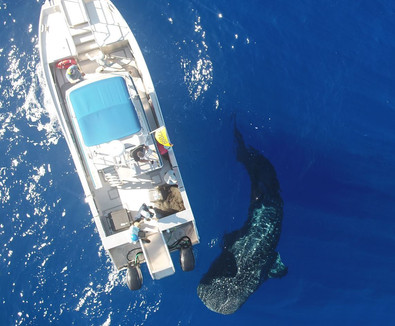Tag team takeover 2.0: Lānaʻi 2023 fieldwork
- MMRP
- Feb 6, 2024
- 4 min read
Members of the MMRP and Pacific Whale Foundation spent the first half of November doing fieldwork off the coast of Lānaʻi. The primary goal of this fieldwork was to deploy Customized Animal Tracking Solutions (CATS) suction-cup tags on false killer whales (Pseudorca crassidens) as part of Jens Currieʻ dissertation research (read more about these tags and this project in last yearʻs Lānaʻi blog post!)
Video made by Jens Currie featuring the tag deployment on a false killer whale, views of spotted dolphins from a tag on a short-finned pilot whale, and views of two false killer whales hunting underwater
2023 was our third year doing fieldwork in Lānaʻi. Although the weather was fairly windy this year, we were able to go out more often and farther offshore due to PWFʻs new research vessel Kaiao.

PWF research biologist Grace Olson (bottom left) and MMRP lab members (top left to right) Lewis, Gussie, Will, Phil, and Bri on board PWFʻs research vessel Kaiao
This year was especially exciting because we deployed a second CATS tag on a false killer whale! We are rarely lucky enough to encounter this endangered species, and every tag deployment helps us better understand their behavior.
On our first day on the water, we found a large group of pantropical spotted dolphins (Stenella attenuata). Closely related to spinner dolphins, spotted dolphins accumulate spots as they age. Pacific Whale Foundation has been studying the Hawaiian population of spotted dolphins for years, using photo identification to monitor population abundance and fisheries interactions through signs of scarring and entanglement.

MMRP graduate students Phil and Gussie taking photos of pantropical spotted dolphins
Later in the morning, we came across a group of false killer whales. We attempted to deploy a tag on a few different individuals, but they were spread very far apart and traveling quickly. After staying with the group for a few hours, we lost sight of the group and the wind picked up. We decided to head home, but were hopeful we would see the group again.
On the second day, we encountered a group of bottlenose dolphins (Tursiops truncatus). Pacific Whale Foundation has also been studying bottlenose dolphins for years, and similar to their work with the spotted dolphins, monitors their population size and fisheries interaction scars. This year, in collaboration with Hawaiʻi Pacific Universityʻs Center for Marine Debris Research (CMDR), we also collected biopsy samples from four bottlenose dolphins. The CMDR is starting a study on how pervasive plastic additives are in dolphin tissue, and at what levels they accumulate. These biopsy samples will be used to better understand how marine plastic debris affects marine mammals.
On the third day, Lorenz from the CATS tag company came from Australia to deliver three new CATS tags. These tags are all rated for use at depths up to 1000 meters, and have headlights on them to illuminate social and foraging behavior at depth. We took the new tags out to test them, and over the course of the next three days, deployed each one on short-finned pilot whales (Globicephala macrorhynchus). We also collected photo-ID and UAV drone data to help estimate population size, age composition, and individual body condition. The acoustic data from the tags deployed on short-finned pilot whales is also important for Briʻs work on the acoustic behavior of blackfish.

PWF research technician Brian (center) and MMRP graduate student Lewis (right) working together to launch the drone over a group of short-finned pilot whales
On the fifth day, we got another lucky chance to deploy a tag on a false killer whale! We found the group right after sunrise, and Lars got a tag on before 8 am. We followed the group to try to deploy another tag on a different animal, but unfortunately the wind and their behavior thwarted our efforts. The tag fell off after 2 hours, but we were able to retrieve it easily and went home to watch the footage. We were excited to see a video of a prey capture event with a mahi mahi. The tag came off when the whale jumped and flung the fish out of the water, but the camera kept recording, and we were able to observe as the fish tried to hide behind the floating tag and the whale attacked.

A false killer whale circling a mahi mahi
A video from the UAS showing a false killer whale surfacing
We didn’t come across the false killer whales again, and the rest of the week we collected more data on spotted dolphins and short-finned pilot whales. We saw a huge ocean sunfish, or mola mola, which are rare in Hawaiʻi. Another highlight for me was seeing a 30 foot-long whale shark! It came right up to the boat, swimming in circles and investigating the engines. Lewis flew the drone over it to estimate the length, and we took underwater photos and videos to send to Hawaiʻi Uncharted Research Collective who keep a catalog of whale sharks in Hawaiʻi. Each whale shark can be identified due to its unique pattern of spots, similar to how dolphins can be identified by notches and scrapes on their dorsal fins.
A photo from the UAS (left) of the whale shark next to Kaiao; an identification photo (right) of the whale shark's unique spots underwater
This year was our most successful Lānaʻi field season to date! We covered 997.1 km, had 28 cetacean encounters, took over 20,500 images and videos, biopsy sampled four bottlenose dolphins and one short-finned pilot whale, and deployed three tags on short-finned pilot whales, and one on a false killer whale. We are grateful to collaborate with Pacific Whale Foundation and our other marine science partners who made this yearʻs field season such a success.





Comments